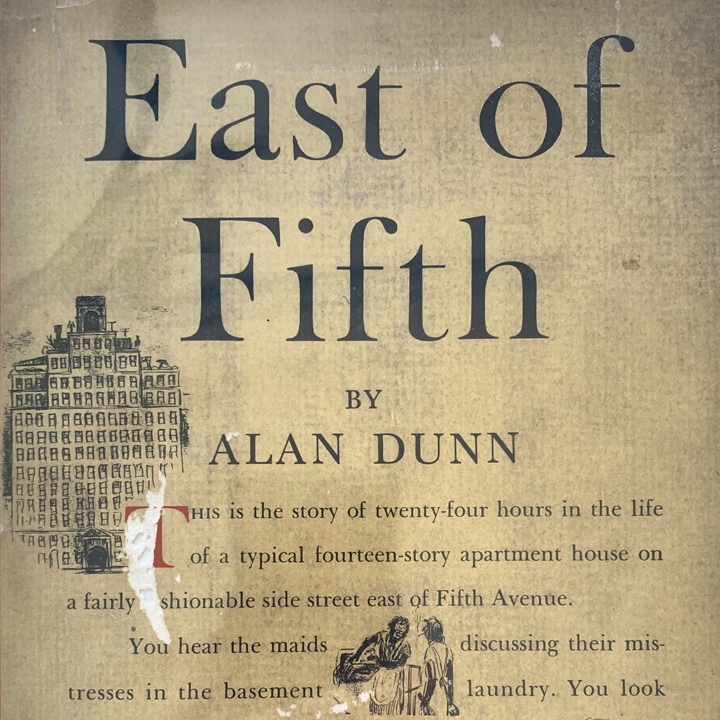The Original Building Stories: East of Fifth by Alan Dunn
Published in 1948, East of Fifth contains a collection of New Yorker style cartoons about life in the big city. Yet by keeping the setting to one location, a fourteen-story apartment building, and to a circulating cast of characters, Dunn has created a proto-graphic novel.
The book unfolds as a series of cartoons tied together with textual exposition. This means that there is little direct juxtaposition in the book. Dunn doesn’t use successive panels to unfold a scene. However, since the same characters keep coming back, we piece together the progress of a narrative by juxtaposing a cartoon against ones scattered previously throughout the pages of the book. So there is juxtaposition, if delayed and not direct. And so the book is a portrait, not merely a collection of cartoons.

However, there are three moments of direct juxtaposition in the book, all of which are composed of two cause and effect pages with the same characters (pages 3-4, 57-58, and 166-167). Dunn has chosen two of these juxtapositions to frame the book, as one of them opens it and another closes it. In all of them, a woman on an upper terrace performs some action, such as overwatering her flowers, which impacts the doorman on the street below. This exchange establishes one of the themes of the book: how members of the upper class unthinkingly impact the long suffering workers who make their privileged lives possible.
Dunn’s critique of class doesn’t extend much beyond this. He often shows how much the workers in the apartment building have to put up with, but the goal is humor. He affectionately makes fun of the vapidity of the endless parties and the cycles of gossip. His humor comes from one who is familiar with these things, not someone who wants to see them changed. However, he does show us the people and machines that make the world of the apartment building possible. In this way, he calls the reader’s attention to the larger reality of the division of labor and the infrastructure and hard work required to keep the carefree life of the upper classes functioning.

Dunn also doesn’t make much of a comment on the racial realities of his setting. He does include a few black characters and, whether intentionally or not, he shows us the types of jobs available to them in 1940s New York. On page 19 two black women are taking out trash, on page 45 a woman does laundry, and on page 95 two women wait on white diners. So while this generation of African-Americans has made it to New York, their existence seems to be only that of servants. That said, the only black man I could see in the whole book (on page 89) looks to be a member of a party. So there is one point of evidence for racial social mobility. Yet the one Asian character in the book is a cook (71) and so also a servant. The apartment building is an ivory tower, in all senses of the term.

As I mentioned in the beginning, Dunn’s art style is what you would expect of a New Yorker cartoonist from the 40s. His line is loose and figures cartoony, but with enough specificity to create a sense of setting and character. He uses a rough shading, perhaps from a litho crayon, to create tonal values in his work. While Dunn’s style may not be terribly unique, I love the tension that comes from his loose, sketchy style and the realism that he is depicting. He rarely varies his approach, but every now and again he will modulate his line to create a certain effect. For instance, on page 136 he uses a double line to denote the sleepless drunkenness of his characters.

While in my title I allude to Ware’s work, East of Fifth is very different from Building Stories. Besides the formal innovation that Ware constantly explores, he presents an emotional depth to his characters that Dunn doesn’t seem interested in. Dunn aims his book at his New Yorker readers and so wants to give them the kind of cartoons that they expect. He is not consciously creating or pushing forward a new medium– the graphic novel– but is instead adding depth to an old one– the magazine cartoon. Still, from our vantage point, we can see how Dunn’s work paves the way for later explorations such as Ware’s. What we have with East of Fifth is an early twentieth century exploration of how a sequence of cartoony images could be used to create a unified work. A cartoon book. A graphic novel.


